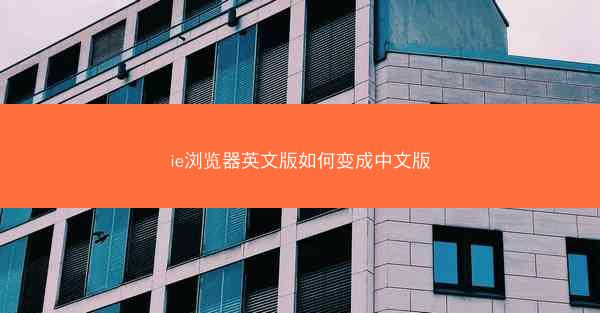ie浏览器英文版如何变成中文版

Unlocking the English IE: A Journey to the Chinese Version
In the vast digital landscape, Internet Explorer (IE) stands as a relic of the past, a browser that once ruled the roost but now finds itself overshadowed by modern giants. For those who have stumbled upon the English version of IE and yearn for a taste of the Chinese language, the quest begins. How does one transform this English-speaking browser into a Chinese-speaking companion? Prepare to embark on a linguistic odyssey as we delve into the art of converting IE from English to Chinese.
The Quest Begins: Identifying the English IE
Before we can embark on our transformation journey, it's crucial to identify the English version of IE that resides on your computer. Whether it's IE 11 or an earlier iteration, the process remains largely the same. Open IE, and take a moment to familiarize yourself with the interface. The English language is a barrier, but it's a temporary one.
The Alchemy of Language: Locating the Language Settings
The heart of the matter lies within the browser's settings. To access these, click on the gear icon in the upper-right corner of the IE window. From the dropdown menu, select Internet options. This is where the magic begins.
The Language Conundrum: Navigating the Options
Once inside the Internet options menu, you'll find a plethora of settings. Look for the Languages tab, often nestled among other tabs like Security and Advanced. Click on it, and you'll be greeted with a list of installed languages and a Add button.
The Power of Addition: Adding Chinese to IE
Click on the Add button, and a new window will appear. Here, you have the power to add any language you desire. For our purpose, we need to find and select the Chinese language pack. This might require some patience, as the list can be extensive. Once you find it, click OK.\
The Language Pack: A Gateway to Chinese
After adding the Chinese language pack, IE will prompt you to restart the browser. This is a critical step, as the language pack needs to be installed and integrated into the browser. Close IE, and relaunch it. The browser will now be ready to embrace the Chinese language.
The Transformation: A New Interface in Chinese
Upon restarting IE, you'll notice a new interface, now adorned with Chinese characters. The English words that once adorned the browser have been replaced with their Chinese counterparts. The toolbar, menus, and settings have all been translated, making the browser a seamless experience for Chinese speakers.
The Final Touch: Customizing Your IE
While the browser is now in Chinese, you might want to further customize it to your liking. This could include changing the homepage, adjusting the search engine, or even tweaking the appearance of the browser. Each setting is now accessible in Chinese, allowing for a fully localized experience.
The Legacy of IE: A New Chapter in Chinese
As you navigate through the transformed IE, you'll find that the browser, once a symbol of a bygone era, now serves as a bridge between the English-speaking world and the Chinese community. The journey from English to Chinese is not just a linguistic shift but a cultural exchange, a testament to the power of technology to connect and communicate across languages.
In conclusion, converting IE from English to Chinese is a straightforward process that opens up a world of possibilities for users who prefer the Chinese language. Whether for personal preference or professional reasons, this transformation is a simple step that can make a significant difference in the browsing experience. So, embrace the change, and let the Chinese version of IE be your guide through the digital realms.
